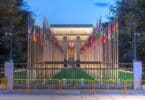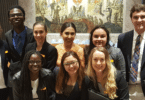When you think of a museum, places like the Smithsonian, Tate Modern, Louvre, The Egyptian Museum or the National Gallery of Victoria leap to mind. Museums are educational spaces that use artifacts and exhibits to bring the past to life. In somewhat recent years, however, a new form of museum has emerged: the human rights museum. These spaces have two purposes: to educate and to warn. Using photographs, objects, and interactive displays, human rights museums examine past violations and remember those affected. Visitors leave with more knowledge and understanding, but the primary hope is that these museums provoke empathy. Empathy is a key part in preventing future injustices.
Learn more about human rights in a free online course by top universities!
Human rights museums are also frequently controversial. Which human rights violations are memorialized, how much space certain events are given, and if certain exhibits are exploitative are common concerns. Here are the top 20 human rights museums around the world:
Liberty Osaka (Osaka, Japan)
First opened in 1985, Liberty Osaka grew from a document archive about the lowest caste within the feudal system into a museum exploring topics such as discrimination against women; the LGBT+ community; ethnic minorities; and the disabled. It also contains stories about Nagasaki and Hiroshima. There’s an English audio guide and booklet.
Canadian Museum for Human Rights (Winnipeg, Canada)
A massive museum project, the Canadian Museum for Human Rights cost over $350 million. It first opened in 2014. Exhibits are put into categories such as women’s rights, collective rights, human rights violations, and human rights promotion. Permanent exhibits include “Protecting Rights in Canada” and “What are Human Rights?” The museum faced a lot of controversy in its early years over its choice of exhibits and what was and wasn’t included. Tours are available.
National Center for Civil and Human Rights (Atlanta, United States)
One of the most famous civil rights museums in the country, the National Center opened in 2014. It contains three permanent exhibits: a collection of Dr. Martin Luther King Jr’s personal belongings; an interactive gallery on segregation, and an exhibit on human rights around the world. The museum also hosts temporary exhibitions. Visitors purchase tickets and there are discounts available for kids, seniors, members of the military, and groups.
Museum of Memory and Human Rights (Santiago, Chile)
In 2010, the Chilean government established the Museum of Memory of Human Rights to educate people about Augusto Pinochet’s dictatorship. Under that regime, many Chileans’ human rights were violated. The museum spans three floors and includes video footage of detention centers, newspapers from that era, and interactive displays. Through the years, the free museum has also hosted exhibits about indigenous Chileans, the torture in Abu Ghraib, and a human rights film festival.
International Civil Rights Center and Museum (Greensboro, United States)
This museum is housed within a Woolworth’s where four North California college students first began the 1960 Greensboro sit-ins. Through reenactments, videos, sets, and historical artifacts, the museum educates visitors on segregation in the United States and how the sit-ins came together. The museum was founded in 1993, opening 50 years to the day after the sit-in movement started.
The National Human Rights Museum (Green Island and Xindian, Taiwan)
From 1949-1987, Taiwan went through the eras of the White Terror and Martial Law. During this time, the government locked up political opponents for “re-education.” Now at Green Island, the former site of a prison camp, you can find a museum complete with many of the old watchtowers. As a memorial museum, it’s designed to educate visitors on the human rights violations that occurred. At the New Life re-education camp in Xindian, visitors can see the barracks and get an idea about life during the White Terror. The National Human Rights Museum first opened in 2018.
The National Civil Rights Museum (Memphis, United States)
This museum, which became a Smithsonian Affiliate in 2016, explores the history of the Civil Rights Movement from the 17th century to now. It’s built around the former Lorraine Motel where Martin Luther King Jr. was shot. In 2019, the museum was one of 10 recipients of the 2019 National Medal for Museum and Library Services, the highest honor given to museums and libraries.
The Sydney Jewish Museum (Sydney, Australia)
First established in 1992 by Holocaust survivors, this museum tells their stories and memoralizes those lost. It also explores other human rights issues in Australia. Exhibits include “The Holocaust,” which is three levels of artifacts, interactive displays, and more detailing the crime against humanity, as well as the lives of survivors who came to Australia. “The Holocaust and Human Rights” exhibit focuses on current Australian human rights issues, such as refugees, First Australians, people with disabilities, and the LGBT+ community.
Birmingham Civil Rights Institute (Birmingham, United States)
Located across from the street from the 16th Street Baptist Church where four young black girls were killed in a 1963 bombing, the Civil Rights Institute first opened in 1992. It uses multimedia exhibits and visuals, such as a set depicting segregated classrooms. Permanent exhibits explore Birmingham’s role in the Civil Rights movement and human rights. The Institute is part of the Smithsonian Affiliations program.
The Armenian Genocide Museum-Institute (Yerevan, Armenia)
Opened in 1995, on the 80th anniversary of the genocide, this museum is built into a hill close to the Genocide Monument. Visiting the museum is part of the state protocol for the Republic of Armenia, so visitors have included popes, presidents, and other politicians. There are three indoor exhibit halls with historical documents and other artifacts. While the Monument memorializes those lost in the genocide, the museum’s intent is to prevent future atrocities.
Auschwitz-Birkenau Memorial and Museum (Oswiecim, Poland)
The former site of a Nazi concentration camp, this memorial and museum serves the dual purposes of memorializing those killed at Auschwitz I and Auschwitz II-Birkenau, and educating visitors about what happened. The museum holds large numbers of items taken from prisoners and discovered after the camp’s liberation in 1945. It also performs Holocaust research. Guided tours take 3 hours.
Anne Frank House (Amsterdam, Netherlands)
During World War II, Anne Frank, her family, and four others lived in hidden rooms at the back of a 17th-century canal house. Today, that building is a museum which opened in 1960. It holds a permanent exhibit on Anne Frank’s life, as well as an exhibit focused on all kinds of discrimination and persecution. It is one of the most visited museums in the Netherlands.
The Ponce Massacre Museum (Ponce, Puerto Rico)
This human rights museum explores the Ponce Massacre, which took place in 1937. At a peaceful civilian march to mark the abolition of slavery and to protest the U.S. government’s imprisonment of the Puerto Rican Nationalist Party leader, police opened fire. 19 civilians and two police officers were killed, and over 200 civilians were wounded. The museum includes a section on the Nationalist leader – Pedro Albizu Campos – as well as many photos from the era. It’s listed in the US National Register of Historic Places.
Trisakti Museum (Jakarta, Indonesia)
This human rights museum examines how students at Trisakti University fought for democracy and human rights. In 1998, police killed four students at a demonstration demanding the president’s resignation. Many more were injured. The police brutality sparked riots all over the country, and eventually, the president stepped down. The museum contains articles, newspaper clippings, photographs, and human relics.
Dallas Holocaust and Human Rights Museum (Dallas, United States)
A new human rights museum (it opened in September 2019), this 55,000 square-foot museum uses unique, immersive technology for its exhibitions. It first started way back in 1977 in the basement of a Jewish community center, but it grew and grew over the years. Objects include prisoner uniforms, cutlery used at the camps, photographs, and a restored boxcar used for Nazi freight transport. The museum also explores genocides in other countries, American civil rights history, and human rights as a whole.
Hiroshima Peace Memorial Park (Hiroshima, Japan)
After the atomic bomb hit, only one building remained in central Hiroshima. Now, it’s part of the Hiroshima Peace Memorial Park. There’s also a museum which examines what happened in Hiroshima and Nagasaki through the testimonies of survivors and personal belongings of those killed. The exhibit also traces the long process of rebuilding and peace activism.
Tuol Sleng Genocide Museum (Phnom Penh, Cambodia)
Pol Pot’s campaign to “cleanse” Cambodia led to a massive number of deaths: over 1 million in four years (1975-1979). The Tuol Sleng Genocide Museum is located in a former prison where detainees were held. Visitors can see paintings by a former inmate and thousands of photos.
U.S. Holocaust Memorial Museum (Washington, D.C., United States)
In 1980, US Congress voted to establish a Holocaust museum. Built on almost 2 acres of land next to the Washington Monument, the museum opened in 1993. The collections include over 12,700 artifacts, millions of pages of documents, thousands of photographs, and 9,000 oral history testimonies. In addition to two permanent exhibits, the museum features rotating exhibits about the Holocaust and human rights.
Nobel Peace Centre (Oslo, Norway)
Opened in 2005, this center focuses on the Nobel Peace Prize, its ideals, and Nobel Peace Prize laureates and their work. Visitors experience interactive displays, exhibits, theater, concerts, and more at the center. As a museum about the Nobel Peace Prize, it isn’t specifically about human rights, but much of the topics and work of laureates involves human rights.
South Africa’s Apartheid Museum (Johannesburg, South Africa)
First opened in 2001, this museum explores the history of apartheid. Exhibits include “Race Classification,” where visitors enter a white or non-white entrance based on randomly-generated entrance tickets, and “Segregation,” which examines the official policy of segregation in South Africa that lay the foundations for apartheid.
Learn more about human rights in a free online course by top universities!












